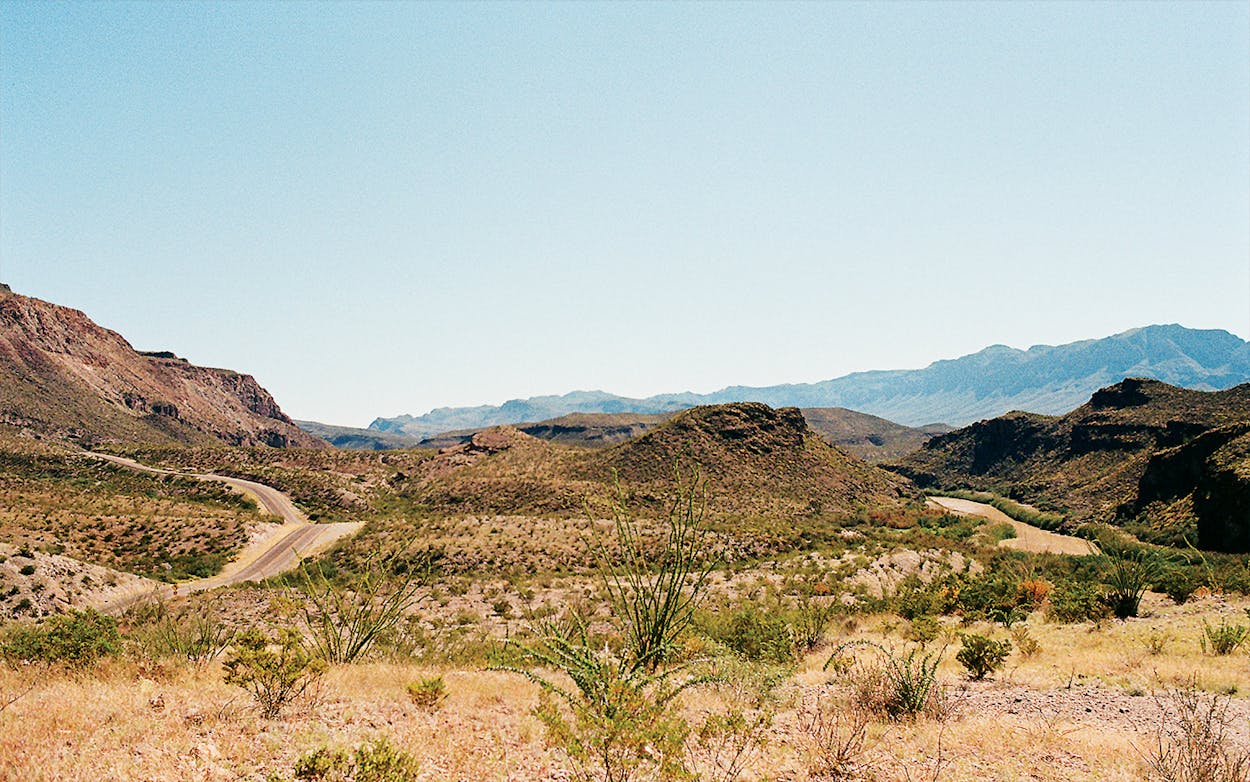“Bring two spares and plenty of gas, and we’ll supply the adventure.” So goes the unofficial motto of Big Bend Ranch State Park, also known as the Other Side of Nowhere, also known as the park most visitors ignore in favor of its more glamorous, only slightly more civilized neighbor just to the east, Big Bend National Park. I confess I’ve long been one of those people, admiring from a car window the craggy land bordering the northern side of River Road, that stunning stretch of FM 170 between Lajitas and Presidio. It always seemed to me mysterious and inaccessible, hard to get a handle on and requiring actual forethought and some measure of planning, two things I’m not particularly good at. And once I got a look at the very detailed topographic map of the largest state park in Texas (311,000 acres) at the outset of a weekend visit with friends, I was tempted to declare that if you’ve seen one patch of desert you’ve seen them all and let’s all go to Terlingua for a beer.
In fact, it wasn’t until 2007 that the general public had more than limited access to the park, almost twenty years after Texas Parks and Wildlife purchased the formerly private ranch land for the perpetual benefit of Texans’ enjoyment, appreciation, and, at times, sheer terror. It is a massive, magnificent chunk of undeveloped wilderness, as close to the original landscape as you can get. It bears witness to thousands of years of human history, evident in the mortars, middens, and pictographs of the area’s indigenous settlers and the weatherworn fences, corrals, and troughs of the later sheepherders and cattle ranchers. And the whole rocky, dry, dusty, prickly expanse is connected only by 153 miles of unpaved former ranch and mining routes. When we called to book our campsite, a remote, primitive site called Vista del Chisos, the ranger said, “You know there’s nothing out there, right? Just you and the animals.”
But, then, nothing is what most people are looking for when they come here. The ranger was referring to the lack of basic necessities, of course: shelter, water, food, 4-ply toilet paper. There’s adventure aplenty, for sure, in the miles of trails for hiking, biking, and horseback riding; in rafting trips down the mostly placid Rio Grande; in planting yourself and your binoculars in a quiet spot and waiting for critters to show up (you can go it alone or sign up with one of the area’s many guides and outfitters). In our limited time, we managed a couple of the easy hikes, like the delightfully named Hoodoos Trail, which wanders through a collection of rock towers standing sentinel over the river. We also made it to the Closed Canyon Trail, where the looming canyon walls do indeed close in on you as you walk a gravel-and-sand path that turns into a boulder-clogged crevice (note: what easily goes down does not as easily come back up) leading to the inaccessible (without gear, that is) Rio Grande.


Saved for our next visit were geological wonders like the Cinco Tinajas, five water-filled rock basins (unusual for the desert), and the famous Solitario, a “collapsed and eroded structural dome” that only those who understand terms like “Caballos Novaculite” and the “Laramide orogeny” can truly appreciate. In other words, it’s ancient and beautiful and will make you feel dumb and small and insignificant, something we could all use a little bit of every once in a while.
To be honest, we backcountry novices got all the adventure we could handle simply getting from one place to another. The journey and the destination are on equal footing out here. Driving through Big Bend Ranch is not for the faint of heart or low of undercarriage. “Be prepared for self-extraction,” warns the TPWD guide to the park’s “unmaintained 4×4 high-clearance roads.” Help is most assuredly not around the corner; it is hours, if not a couple days, away, and that’s if you manage to alert anyone to your predicament. I fell deeply in love with our rented vehicle, a 2018 four-door Jeep Wrangler Unlimited Sahara whose brawny confines, painted in an elegant but rugged “Granite Crystal,” cradled me and my petrified passengers in uneasy comfort as we crept through loose sand, navigated drop-offs, and more than once found ourselves paused at a disconcerting incline, more sky than land visible through the windshield. When our trusty steed finally deposited us at Vista del Chisos, we were more than ready for the simple, reassuring rituals that accompany spending the night out-of-doors: setting up the tents, starting a fire, finding a cactus-free nook to situate the orange Home Depot bucket you’re praying you won’t need (Lord, please, let’s not do this).
It sounds clichéd, but life gets back to basics pretty quickly in the bowels of Big Bend Ranch; how wonderful that the only useful parts of your phone are the flashlight and camera and constellation maps (BBRSP was designated an International Dark Sky Park in 2017). After a couple uneventful evenings of wienie roasting, tequila sipping, skygazing, and fireside philosophizing, we can report that there is indeed nothing out there. That is, if you define “out there” as Edward Abbey does in Desert Solitaire, as a different world that’s “older and greater and deeper by far than ours, a world which surrounds and sustains the little world of men as sea and sky surround and sustain a ship.”

Hoodoo You Love?
Hoodoos, the otherworldly rock formations that look like precarious toadstools, were carved by millions of years of wind and water erosion.
No, there’s nothing but purple sunsets and shooting stars and a moon that delights you with its astonishing brightness (until it shines right through your tent all night). Nothing but the mournful wind and the cheerful birds and a plump walking stick that’s found its way into your hair and is as nonplussed about it as you are. Nothing but a giant Longhorn standing aside the so-called road, calmly watching you bounce your way back to so-called civilization.
We had left Vista del Chisos with what Abbey calls a “reawakened awareness of the wonderful,” which sustained us on our three-hour, 33-mile, teeth-rattling journey out of the park. That is, until we pulled into Lajitas, fantasizing about frosty margaritas and proper plumbing at the posh resort there, and were unceremoniously met with the raucous sounds of a wedding reception (“I like big butts and I cannot lie”) and a few half-clothed celebrants running around. After checking in, we retreated to the relative quiet of the patio outside our room, where we sat and observed a small herd of javelinas rooting about the grounds, one of which somehow fell into the courtyard’s sparkling fountain. After a bit of frantic struggle, the unabashed ungulate managed to scramble out, and we had half a mind to follow as he disappeared into the great, deep dark.
This article originally appeared in the January 2019 issue of Texas Monthly with the headline “Where Nothing Is Everything.” Subscribe today.
- More About:
- Parks & Recs
- Big Bend









